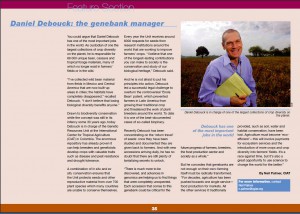- Learn urban aquaculture.
- Learn phylogenetics online.
- Learn about the CGIAR’s manifesto for agriculture and climate change from Andy’s new blog.
- Learn about the importance of hide processing in East Africa.
- Learn about the latest blow to British cooking.
- Learn about monastic gardening.
- Learn about the USDA’s microbial collections. They’re agrobiodiversity too.
- Learn what is the latest crop to get its genome sequenced.
- Learn about a private livestock genebank in the US.
- Learn about the effect of biofuel crop diversity on insect diversity.
Bill Gates on genebanks and their databases
From Bill Gates’ annual letter on the work of his foundation:
There are three things that modern agrotechnology brings to this seed improvement process. The first is simply the ability to gather plant samples from all over the world and use databases to keep track of thousands of plants grown under different conditions.
The second is sequencing and the third is transgenics, in case you were wondering. One of these days, I’d like to take Mr Gates down into Genebank Database Hell. But hey, we’re working on it. And the Foundation is helping.
How old is that lentil?
You may remember yesterday’s nibble about the allegedly 4,000-year-old lentil from an archaeological site in Turkey which actually germinated. Intrigued, I ran the news item by some colleagues at Kew. They pointed me to a New Scientist article from a few years back which describes their attempt to verify a previous alleged example of very old seed (from the sarcophagus of an Egyptian mummy, in fact) germinating. The thing is, you can predict pretty well how seed will behave over time if you know the temperature and relative humidity of the conditions. You just plug those numbers into a fairly well known and understood equation.
Dickie found that if he started with top-quality seed and the temperature remained constant at 16 °C, one grain in a thousand might still germinate after 236 years. With the temperature sometimes hitting the high 20s, the grain would all be dead in 89 years. And if the seed was less than perfect to begin with…
So let’s just say I’ll be personally needing some fairly solid evidence for the age of that lentil.
Genebank manager in the spotlight
Daniel Debouck, genebank manager at CIAT in Colombia, is featured in the next issue of Bioversity’s Geneflow magazine. Daniel is a world expert on beans. And an esteemed colleague.

Nibbles: Tomatoes, Fattipuffs, Thinifers, Rice, Policy, IFAP, Small oats, Yams, Drought insurance, Siberian nomads, Cereal miscegenation, Fiji breadfruit, Introgression, Mudchute, Gordon Edgar, Coconuts, Eels, Cat worship, Biofuel breeding, Perennials
- Some heirloom tomatoes resist late blight, others not so much.
- Overweight or obese Americans at 68%, and holding steady. No epidemic, say free-thinkers.
- “No wonder kids are gaining weight.” But they aren’t, see above. (Where’s that sarc-mark when you need it?)
- Hydroelectric scheme to save Ifugao rice terraces, cut carbon emissions. W-w-w?
- Climate Change and Agrobiodiversity updates us on hot policy news. Thanks.
- IFAP updates its farmers on agricultural biodiversity. Thanks again.
- Small oats genebank evaluations make big progress with young crofters.
- Yam festivities in the Philippines.
- Psst, you want drought insurance for your camel herd? Oh, and Jeremy wants to know why this IFPRI stuff didn’t find its way into the story.
- “The ability to roam freely enables people and animals to exploit or avoid a wide range of natural and manmade habitats.” Still no cure for cancer.
- Barley helps wheat. But how, exactly? I think we should be told.
- Fiji sets up breadfruit genebank Which will hopefully help local agricultural entrepreneurs.
- Anastasia on introgression. At length.
- The biggest urban farm in Europe.
- A bite of Cheese(monger).
- Coconuts bad for birds bad for soil bad for plants bad for crabs. Ok then, let’s cut the damn things down, shall we?
- Cockney cuisine takes a turn for the worse. Well would you Adam and Eve it?
- Egyptian cat temple pix. Miaow.
- “…the first biofuel crop breeding programs for low-input systems are likely to accelerate progress by focusing on grass–legume bicultures.”
- And another from the Land Institute: “…harvested perennial
grasslands provide valuable ecological benchmarks for agricultural sustainability.”